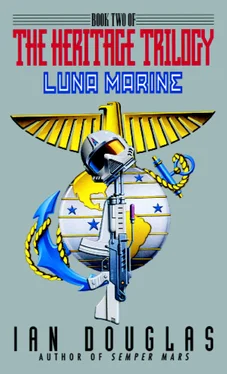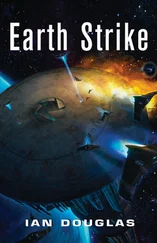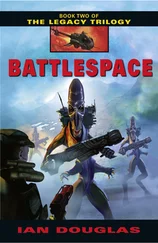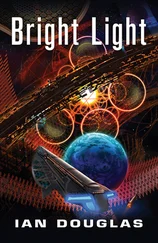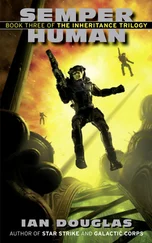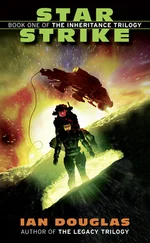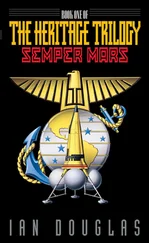And it was damned hard to say no to a government-backed request.
“You’re also already rated for a pressure suit and pliss,” Sarah told him.
True enough. In fact, he’d already been to the Moon, briefly, as part of his astronautics training in preparation for his flight to Mars. He’d spent three days at Fra Mauro and been bored most of the time, even with a crowded training schedule.
“Can I take anyone along? Dr. Sullivan has been working with me on…”
“I’m sorry, Doctor. Space is limited, and there’s no time for training.”
Teri was going to be disappointed. Hell, he was disappointed…but the thought of getting into the field again—and on the Moon!—was too much to resist.
Besides, he knew what LEO-Lunar transports were like. There’d have been no privacy, no opportunity to give Teri a chance to join the Three Dolphin Club.
Later, after his visitors had left, David stood at the window looking down at the demonstrators outside, thoughtful. There was someone he needed to talk to just now.
Someone he wasn’t supposed to talk to at all….
EU Science Research Vessel
Pierre-Simon Laplace
Co-orbit with Asteroid 2034L
2235 hours GMT
Dr. Jean-Etienne Cheseaux floated alongside the Laplace’s tiny observation port, slipping his dark glasses into place as sunlight flooded into the compartment. Outside, the sun was just clearing the edge of the Rock as the ship’s slow drift brought her clear of the small planetoid’s shadow. He still wondered why the Académie des Sciences had insisted that he come here.
Cheseaux was an astronomer; his primary specialization was selenology, the geology of the Moon, but the Academy had asked him to serve as payload specialist aboard the Laplace. Not that he was complaining, necessarily—he liked it in space, enjoyed the sensations of free fall and the spectacular purity of the sunlight—but the measurements he was taking of 2034L’s mass and spin and precise orbit could have been made by any competent technician. It was, he supposed, an indication of the importance the Academy attached to this mission. The knowledge stirred his professional pride, and his ego; there was talk, he’d heard, of naming this particular rock Cheseaux. Of course, the astronomical society frowned on using the names of living people, but there were precedents.
Asteroid 2034L had been discovered eight years ago, one of the fast-growing number of near-Earth asteroids whose orbits carried them periodically inside the orbit of Earth. This one was particularly disturbing; as carbonaceous chondrite, like the majority of asteroids, it had an extremely low albedo, rendering its surface as black as the blackest coal. It was also small, less than a hundred meters across.
That combination of orbit, albedo, and small size made 2034L particularly dangerous, a prime target for the Phaeton Project. In Greek mythology, Phaeton was the boy who’d lost control of Apollo’s sun-chariot, bringing it too near the Earth and nearly destroying humanity in fire. Since the 1980s, the particular danger Earth-crossing asteroids and comets represented to the Earth had been well understood; the lesson of the dinosaurs, exterminated by the ten-mile body that had smashed into the Yucatán sixty-five million years ago, could not be ignored. By the early 2000s, several skywatch operations were in place, identifying and charting the flying mountains that might someday pose a direct threat to Earth and her inhabitants.
Phaeton, one of the most comprehensive of the sky-watch programs, had been begun in 2029, a collaboration between the European Union, Japan, and the United States. The UN had assumed financial responsibility five years later, the same year in which 2034L had been discovered. The war, of course, had interfered to the extent that neither the United States nor Japan was participating any longer, but the work was vital enough that the EU Space Agency had continued the program, war or no war.
Cheseaux was now confident that this rock, at least, posed no immediate threat to humanity. With precise measurements now complete, he could confidently report that 2034L would pass within a million kilometers of the Earth in another five months. That was twice the distance from Earth to the Moon, a cat’s whisker when you looked at the sheer size of the whole solar system, but comfortable enough as a margin of safety. He would need to run his figures through the supercomputer center at the Sorbonne to be sure, but back-of-the-envelope calculations suggested that 2034L would again pass close by the Earth in another forty-five years. That passage would be a near miss of perhaps one hundred thousand kilometers that would slingshot the body in toward the sun…which in turn would either destroy the asteroid in celestial flame or send it careening out into the thin, cold dark of the outer system.
Either way, this particular Earth-crosser posed no threat.
“Upload complete, Doctor,” Laplace’s commander, Colonel Denis Armand, announced, drifting alongside of Cheseaux in a head-down position relative to him. “They have asked us to hold our position, however, until another vessel can rendezvous with us.”
“Another craft? What other craft?”
Armand gave a Gallic, inverted shrug, then reached out to brace himself against the bulkhead before he started turning. “They didn’t say. The war, after all…”
Cheseaux gave a soft grunt of understanding. It was always the war. Abject foolishness! The European Union needed to be working with the Americans and the Japanese and even the Russians, now…not fighting them. The Americans had already slammed the door to Mars shut in the UN’s face rather decisively; the UN risked losing access to the Moon as well, if they persisted in this insanity. It was time to end this, declare a truce, and find out how best to get all of humankind working on the problems of recovering and learning from the newly discovered alien technology.
Squinting against the sunlight, Cheseaux looked for and found a pair of tiny crescents, one silver, one gray, well beyond the horizon of 2034L and bowed away from the sun. Earth was now less than ten million kilometers away, its attendant moon somewhat farther. Both seemed transcendently delicate, ethereal, and small. The war that had wracked the world for the past two years, the burning political questions of Aztlan independence and control of ancient alien technologies all seemed so completely insignificant from this vantage point. It was true, what they said: Looking back at the Earth from space gave one an entirely new perspective, a new outlook.
Perhaps it was Earth’s politicians who should be shipped up here, the lot of them, and not her scientists and soldiers. Let them work out their differences bathed in heavenly radiance, with the Earth nothing more than a frail, silver sliver in the night.
“Well, I think I’ll turn in,” he told the commander. “Let me know if there’s a call from Earth.”
“Of course.”
Laplace was neither large nor luxurious, even as space-craft went. Her hab module and laboratory together were ten meters long and five wide, small enough to have fit easily inside the living and working area of the old Skylab, and she carried twice as many people, three crew and three payload specialists. Cheseaux’s cabin was a closet-sized space in the aft of the hab module with thin plastic walls and a sleeping bag attached to the bulkhead. His “desk” pulled out from one of the walls, a plastic board with Velcro surfaces, to which his laptop was attached.
Pulling the folding panel shut behind him—the only concession to the human need for privacy aboard—he peeled his computer from the desk and wiggled into the sleeping bag so that he didn’t have to think about not floating about. Outside his cabin, the bumps and thumps, the conversations, the smells of ready-heat meals and men in close confinement continued to permeate his world. As much as he’d been enjoying this mission, he was going to be glad to get back to Paris. He’d actually felt, he realized now, a pang of disappointment a few minutes ago when he’d learned Laplace would not be immediately returning home.
Читать дальше
